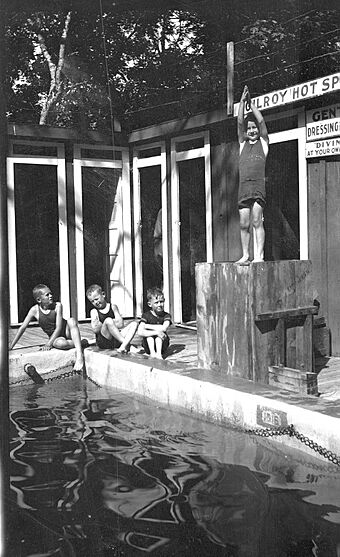Gilroy Yamato Hot Springs facts for kids
Quick facts for kids |
|
|
Gilroy Yamato Hot Springs
|
|

Gilroy Yamato Hot Springs pool, ca. 1920
|
|
| Nearest city | Gilroy, California |
|---|---|
| Area | 8 acres (3.2 ha) |
| Architectural style | Italianate–Victorian |
| NRHP reference No. | 95000996 |
| Added to NRHP | August 21, 1995 |
Gilroy Yamato Hot Springs is a special place near Gilroy, California. It is famous for its warm, mineral-rich hot springs. This historic spot is recognized as a California Historical Landmark. It is also listed on the National Register of Historic Places.
The area was developed by early settlers and later by Japanese immigrants. Some buildings from the 1870s are still there. These include structures built in the Italianate and Victorian style. An old bathhouse from 1890 also remains. Later additions include a Buddhist shrine and a Japanese garden teahouse, both from 1939. The hot springs are quite warm, usually between 99° and 111 °F (37° to 44 °C). Tiny living things that love hot places can even survive in these springs!
Contents
Discovering the Hot Springs
This historic site sits in a forest of oak trees. It is located above Coyote Creek. This is about ten miles northeast of Gilroy. Francisco Cantua is linked to the early discovery of these springs.
In 1866, George W. Roop and William F. Olden bought the main land area. Roop built a resort that became very popular. It could host up to 200 guests each day. People in the 1870s called it "the finest springs in the state."
Early Buildings and Guests
An old three-story wooden hotel was built in 1874. A one-story wooden clubhouse also dates from the 1870s. In the 1890s, more buildings were added. These included the bathhouse and several guest cabins. A wooden kiosk was also built over one of the hot springs.
Many famous people visited this resort. These guests included San Francisco Mayor James Phelan. Gold mining leader Adolph Sutro and businessman Claus Spreckels also stayed here. Singer Margaret Alverson Blake was another notable visitor.
The Roaring Twenties Era
The 1920s were a lively time in American history. More improvements came to Gilroy Hot Springs. A large redwood water tank was built in 1913. The first concrete pool for mineral water was added in 1917.
In the early 1920s, William and Emily McDonald bought the property. They added more guest cabins, bringing the total to 24. Each cabin was named after a different state. The cabin named Arizona was built in 1924. Sadly, it burned down in 1992. Many of the other cabins from the 1920s are still standing today.
Fun Times at the Resort
Gilroy Hot Springs was a very social place back then. People came for birthday parties and swimming fun. There were also Saturday night dances and local club gatherings. Over 500 people visited the resort daily in the summer. The San Francisco Motorcycle Club had a big event here in 1920.
More and more people started using cars in this era. So, many trees were cut down along Gilroy Hot Springs Road. This made it easier for cars to reach the resort. However, the Great Depression began at the end of the 1920s. This caused fewer people to visit the resort. William McDonald passed away, and the property faced financial trouble. By 1934, the Gilroy Hot Springs Post Office closed. In 1935, train service to the resort also stopped.
Japanese Influence Begins
On September 15, 1938, a newspaper headline announced big news. It said, "Japanese Capitalist Buys Famed Gilroy Hot Springs Resort." Kyuzaburo Sakata, a successful Japanese lettuce farmer, bought the resort. He planned to build a Japanese garden. This garden would be designed by Nagao Sakurai, who worked for the Imperial Palace in Japan. Sakurai also helped with the Japanese exhibit at the 1939 Golden Gate Exposition in San Francisco.
Gilroy Hot Springs became a symbol for Americans of Japanese ancestry. It showed their success in achieving their dreams in America. Unlike some other groups, Japanese settlers worked hard within the system. They wanted to own property and build a life. The hot springs reminded them of similar places in their home country.
World War II and After
After the attack on Pearl Harbor, things changed. Sakata and many other Japanese Americans were sent to Internment Camps. During the war, Sakata's non-Japanese business partners kept the resort running. But it was not as grand as before.
After being released from the camp, Sakata returned. He became the owner and manager again. He invited other Japanese Americans to visit the springs. He called it "a blessing nature created... in our search for the power of healing." It became a place where Japanese Americans and European Americans could meet and relax together.
Modern Times
The sleeping annex building was taken down in 1946. In 1964, Sakata could not afford to update the cabin heating systems. County rules had changed, and he needed to meet new codes. So, he sold the property to Philip S. Grimes. Grimes was a landscape architect.
The old hotel and clubhouse burned down in 1980. The property was run as a private resort until 1988. Then, Fukuyama International, Inc., from Japan, bought it. Fukuyama planned to fix up the property. They wanted to make it a Japanese American cultural and recreation center. They also made sure it was recognized as a California Historical Landmark.
In 2003, the California Department of Parks and Recreation bought the property. It became part of Henry W. Coe State Park. The hot springs are currently closed to the public. Many buildings have been damaged by weather and people. The park is working on a plan for the future of this historic site.



